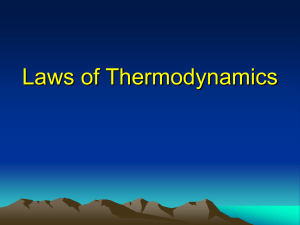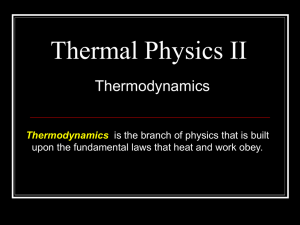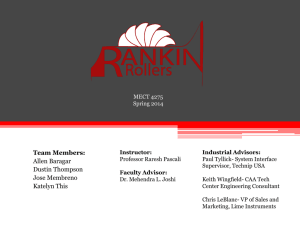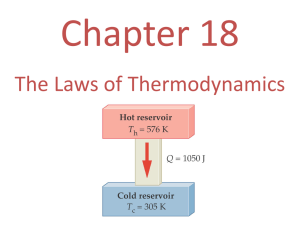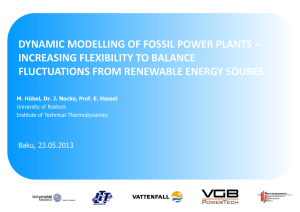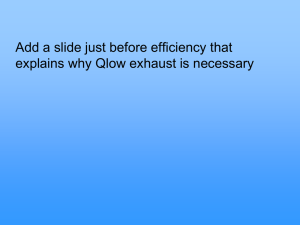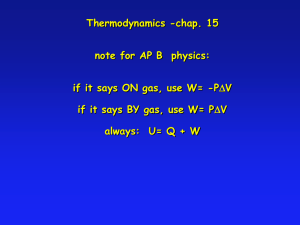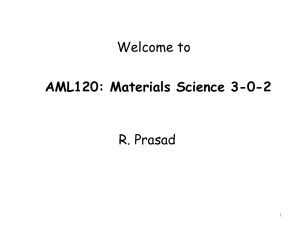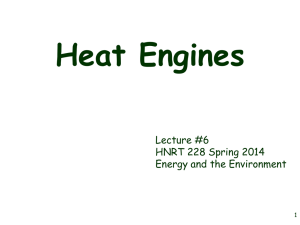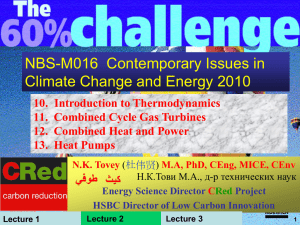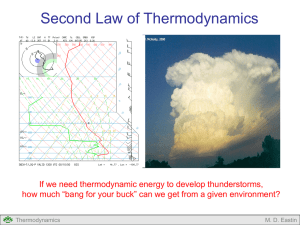Sections 8 – 9 of Handout
advertisement
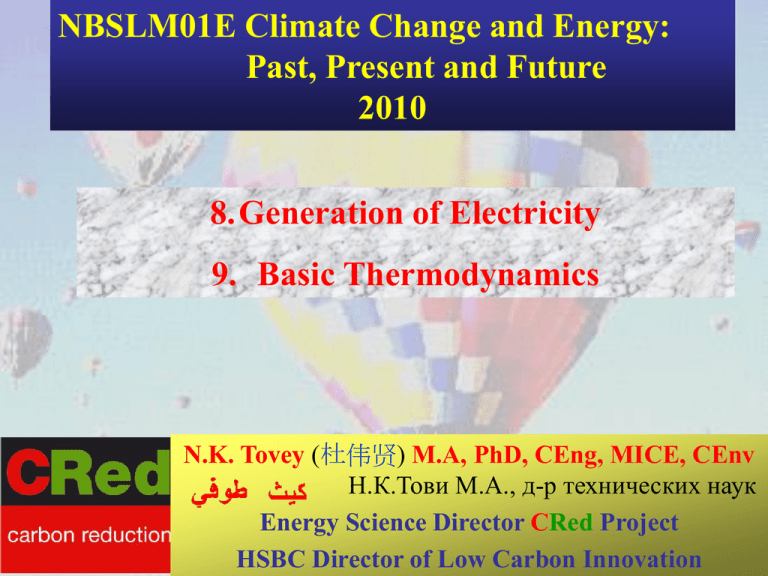
NBSLM01E Climate Change and Energy: Past, Present and Future 2010 8.Generation of Electricity 9. Basic Thermodynamics N.K. Tovey (杜伟贤) M.A, PhD, CEng, MICE, CEnv Н.К.Тови М.А., д-р технических наук Maxine Narburgh Energy Science Director CRed Project 1 HSBC Director of Low CarbonCSERGE Innovation 8. Generation of Electricity - Conventional Largest loss in Power Station Overall efficiency ~ 35% Diagram illustrates situation with coal, oil, or nuclear Gas Generation is more efficient - overall ~ 45% 2 8. Generation of Electricity - Conventional. Superheated Steam 563oC 160 bar Multi-stage Turbine Generator Boiler Why do we condense the steam to water only to heat it up again?. Does this not waste energy? Pump NO!! Steam at ~ 0.03 bar Condenser But we must wait until the Thermodynamics section to understand why? Simplified Diagram of a “generating set” includes boiler, turbine, generator, and condenser 3 8. Generation of Electricity - Conventional Chemical Energy Coal / Oil / Gas 100 units Power Station Heat Energy 90 units Boiler 90% Turbine Generator 95% Electrical Energy 48% 41 units Mechanical Energy Electricity used in Station 3 units 38 units 4 8. Generation of Electricity - Conventional. Why not use the heat from power station? - it is typically at 30oC? Too cold for space heating as radiators must be operated ~ 60+oC What about fish farming - tomato growing? - Yes, but this only represent about 0.005% of heat output. Problem is that if we increase the output temperature of the heat from the power station we get less electricity. Does this matter if overall energy supply is increased? 5 8. Generation of Electricity - CHP Overall Efficiency - 73% •Heat is rejected at ~ 90oC for supply to heat buildings. •City Wide schemes are common in Eastern Europe 6 8. Generation of Electricity - Conventional. 1947 Electricity Act blinked our approach for 35 years into attempting to get as much electricity from fuel rather than as much energy. Since Privatisation, opportunities for CHP have increased on an individual complex basis (e.g. UEA), unlike Russia A problem: need to always reject heat. What happens in summer when heating is not required? Need to understand basic thermodynamics 7 NBSLM01E Climate Change and Energy: Past, Present and Future 2010 9. Introduction to Thermodynamics N.K. Tovey (杜伟贤) M.A, PhD, CEng, MICE, CEnv Н.К.Тови М.А., д-р технических наук Energy Science Director CRed Project 8 HSBC Director of Low Carbon Innovation 9. Elementary Thermodynamics - History. Problem: Cylinder continually is cooled and heated. 1) Boil Water > Steam 2) Open steam valve pushes piston up (and pumping rod down) 3) At end of stroke, close steam value open injection valve 4) Water sprays in condenses steam in cylinder creating a vacuum and sucks piston down - and pumping rod up Newcomen Engine 9 9. Elementary Thermodynamics - Watt Engine. 1) Cylinder is always warm 2) cold water is injected into condenser 3) vacuum is maintained in condenser so “suck” out exhaust steam. 4) steam pushes piston down pulling up pumping rod. Higher pressure steam used in pumping part of cycle. Watt Engine 10 9. Elementary Thermodynamics. Thermodynamics is a subject involving logical reasoning. Much of it was developed by intuitive reasoning. • 1825 - 2nd Law of Thermodynamics - Carnot • 1849 - 1st Law of Thermodynamics - Joule • Zeroth Law - more fundamental - a statement about measurement of temperature • Third Law - of limited relevance for this Course 11 9. Elementary Thermodynamics. Carnot’s reasoning Water at top has potential energy Water at bottom has lost potential energy but gained kinetic energy 12 9. Elementary Thermodynamics. Carnot’s reasoning Water looses potential energy H1 Part converted into rotational energy of wheel Potential Energy = mgh H2 • Theoretical Energy Available = m g (H1 - H2) • Practically we can achieve 85 - 90% of this 13 9. Elementary Thermodynamics. Carnot’s reasoning Temperature was analogous to Head of Water • Energy Temperature Difference • Energy (T1 - T2) • T1 is inlet temperature • T2 is outlet temperature • Just as amount of water flowing in = water flowing out. • Heat flowing in = heat flowing out. • In this respect Carnot was wrong • However, in his day the difference was < 1% 14 9. Elementary Thermodynamics. Joule 1849 • Identified that “Lost” Heat = energy out as Work • Use a paddle wheel to stir water - the water will heat up • Mechanical Equivalent of Heat Berlin Demonstration Symbols W - work Over a complete cycle Q = W Heat in +ve Q - heat Heat out -ve Work in -ve Work out +ve FIRST LAW: “You can’t get something for nothing” 15 9. Elementary Thermodynamics. First Law: Heat In Q1 W = Q 1 - Q2 so efficiency Heat Engine Work Out W Heat Out Q2 Work Out Heat In Q1 Q 2 Q1 But Carnot saw that Schematic Representation of a Power Unit Heat • What do we mean by temperature? Celcius, Fahrenheit, Reamur, Temperature T1 T2 T1 Rankine, Kelvin? • Which should we use? 16 9. Elementary Thermodynamics. T1 T2 T1 Is this a sensible definition of efficiency? If T1 = 527oC ( = 527 + 273 = 800K) and T2 = 27oC ( = 300K) 800 300 62.5% 800 Note: This is a theoretical MAXIMUM efficiency Work Out Heat Out W Q 2 why not Heat In Q1 Q1 Q 2 Q 2 100% Q1 17 9. Elementary Thermodynamics. Second Law is more restrictive than First “It is impossible to construct a device operating in a cycle which exchanges heat with a SINGLE reservoir and does an equal amount of work on the surrounds” This means Heat must always be rejected Second Law cannot be proved - fail to disprove the Law If heat is rejected at 87oC (360K) By keeping T2 at a potentially useful temperature, efficiency has fallen from 62.5% 800 360 55.0% 800 18 9. Elementary Thermodynamics. The Practical efficiency will always be less than the Theoretical Carnot Efficiency. To obtain the "real" efficiency we define the term Isentropic Efficiency as follows:- isen actual work out work predicted from Carnot Efficiency Thus "real" efficiency = carnot x isen Typical values of isen are in range 75 - 80% Hence in a normal turbine, actual efficiency = 48% A power station involves several energy conversions. The overall efficiency is obtained from the product of the efficiencies of the respective stages. 19 9. Elementary Thermodynamics. EXAMPLE: In a large coal fired power station like DRAX (4000MW), the steam inlet temperature is 566oC and the exhaust temperature to the condenser is around 30oC. The combustion efficiency is around 90%, while the generator efficiency is 95% and the isentropic efficiency is 75%. If 6% of the electricity generated is used on the station itself, and transmission losses amount to 5% and the primary energy ratio is 1.02, how much primary energy must be extracted to deliver 1 unit of electricity to the consumer? 20 9. Elementary Thermodynamics. (566 + 273) - (30 + 273) Carnot efficiency = ------------------------------ = 63.9% 566 + 273 so overall efficiency in power station:- = 0.9 | x 0.639 | x 0.75 | x 0.95 x | combustion Carnot Isentropic Generator loss efficiency efficiency efficiency 0.94 = 0.385 | Station use 21 10. Elementary Thermodynamics. Transmission Loss ~ 91.5% efficient Primary Energy Ratio for Coal ~ 1.02 Overall efficiency = 1 x 0.385 x 0.915 -------------------------- = 0.345 units of delivered energy 1.02 i.e. 1 / 0.345 = 2.90 units of primary energy are needed to deliver 1 unit of electricity. 22 9. Elementary Thermodynamics. T1 T2 T1 How can we improve Carnot Efficiency? Increase T1 or decrease T2 If T2 ~ 0 the efficiency approaches 100% T2 cannot be lower than around 0 - 30oC i.e. 273 - 300 K T1 can be increased, but properties of steam limit maximum temperature to around 600oC, (873K) 23 9. Elementary Thermodynamics. In this part of the lecture we shall explore ways to improve efficiency We need to work with thermodynamics rather than against it The most important equation: T1 T2 T1 Q1 Q2 Q1 What if we could use Q2 effectively? 24 9. Applications of Thermodynamics - CHP Overall Efficiency - 73% •Heat is rejected at ~ 90oC for supply to heat buildings. •City Wide schemes are common in Eastern Europe 25 Ways to Respond to the Challenge: Technical Issues Combined Heat and Power • Pipes being laid in streets in Copenhagen • Most towns in Denmark have city wide schemes such as these • Pipes like these were recently laid in UEA to new Thomas Paine Building 26 26 9. Applications of Thermodynamics. Combined Heat and Power Engine Generator 27 Working with Thermodynamics. Heat Pumps Heat Out Q1 Heat Pump Work IN W Heat In Q2 Schematic Representation of a Heat Pump A Heat Pump is a reversed Heat Engine: NOT a reversed Refrigerator COP Heat Out Work In COP Q1 Q1 Q 2 T1 T1 T2 If T1 = 323K (50oC) and T2 = 273K (0oC) 323 COP 6.46 323 273 Schematic Representation of a Heat Pump. IT IS NOT A REVERSED REFRIGERATOR. 28 Working with Thermodynamics. Heat Pumps and Refrigerators A heat pump refrigerator consists of four parts:- Throttle Valve Condenser Evaporator Compressor 1) an evaporator (operating under low pressure and temperature) 2) a compressor to raise the pressure of the working fluid 3) a condenser (operating under high pressure and temperature) 4) a throttle value to reduce the pressure from high to low. 29 Responding to the Challenge: Technical Solutions The Heat Pump Heat supplied to house High Temperature High Pressure Condenser Throttle Valve Compressor Evaporator Heat extracted from outside Low Temperature Low Pressure Any low grade source of heat may be used • Typically coils buried in garden • Bore holes • Example of roof solar panel A heat pump delivers 3, 4, or even 5 times as much heat as electricity put in. We are working with thermodynamics not against it. 30 30 Types of Heat Pump air Heat Sink air air to air water air to water solid air to solid Heat Source water water to air water to water water to solid ground ground to air ground to water ground to solid For Space Heating Purposes: The heat source with water and the ground will involve laying coils of pipes in the relevant medium passing water, with anti-freeze to the heat exchanger. In air-source heat pumps, air can be passed directly through the heat exchanger. For Process Heat Schemes: the source may be a heat exchanger in the effluent of one process 31 Recipient of James Watt Gold Medal Keith Tovey (杜伟贤) Н.К.Тови M.A., PhD, CEng, MICE, CEnv Energy Science Director: Low Carbon Innovation Centre School of Environmental Sciences, UEA. Rotary Club of Norwich 33

